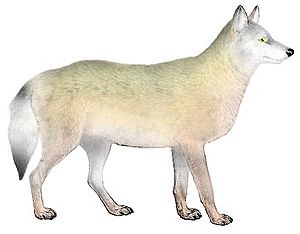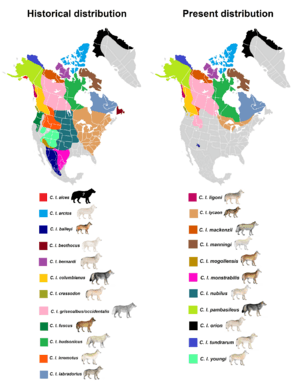Southern Rocky Mountain wolf facts for kids
Quick facts for kids Southern Rocky Mountains wolf |
|
|---|---|
 |
|
| Illustration based on a description by Edward Alphonso Goldman | |
| Conservation status | |
|
Extinct (1935)
|
|
| Scientific classification |
|
| Kingdom: | Animalia |
| Phylum: | Chordata |
| Class: | Mammalia |
| Order: | Carnivora |
| Family: | Canidae |
| Genus: | Canis |
| Species: | |
| Subspecies: |
†C. l. youngi
|
| Trinomial name | |
| Canis lupus youngi Goldman, 1937
|
|
 |
|
| Historical and present range of gray wolf subspecies in North America | |
The southern Rocky Mountain wolf (Canis lupus youngi) was a type of gray wolf. It is now extinct, meaning it no longer exists anywhere. This wolf used to live in the western United States.
It was found in places like southeastern Idaho and southwestern Wyoming. It also lived in parts of Utah, Colorado, and New Mexico. This wolf was a medium size. It had light-colored fur. It looked a lot like the Great Plains wolf. However, it was a bit bigger. It also had more dark hairs on its back. This wolf disappeared by 1935. Today, other kinds of wolves, like the Northwestern wolf, have been brought back to Idaho and Wyoming.
Contents
What Is a Southern Rocky Mountain Wolf?
The Southern Rocky Mountain wolf was a specific kind of gray wolf subspecies. A subspecies is a group of animals within a species. These animals look a bit different. They also live in different areas. But they can still breed with other animals of the same species.
Where Did These Wolves Live?
These wolves lived in the Rocky Mountains area. Their home stretched across many states. This included parts of Idaho, Wyoming, and Nevada. They were also found in Utah, Colorado, and Arizona. Their territory also reached into New Mexico.
Studying Wolf History Through DNA
Scientists study the history of wolves. They use something called DNA. DNA is like a blueprint for living things. It tells us about an animal's family tree.
How DNA Helps Us Learn About Wolves
One type of DNA is called mitochondrial DNA (mDNA). This mDNA is passed down from mothers. It can show how animals are related. It can also show how they moved over thousands of years.
In 2005, scientists looked at mDNA from old wolves. They compared it to mDNA from modern wolves. The old wolf samples were from 1856 to 1915. They found that old wolves had more different types of mDNA. This means they had more genetic diversity. Genetic diversity is like having many different kinds of traits in a group. It makes a group stronger.
The "Southern Clade" of Wolves
Scientists found something special. Some mDNA types were unique. These were from the Mexican wolf. They were also from the extinct Great Plains wolf. And they were from the extinct Southern Rocky Mountain wolf. These unique types formed a special group. This group is called a "southern clade". A clade is a group of animals that share a common ancestor.
Most North American wolves are related to wolves from Europe and Asia. But this "southern clade" is different. It is found only in North America. This shows that these wolves were unique. It also suggests that wolves moved around a lot. They shared genes across their large territories.

